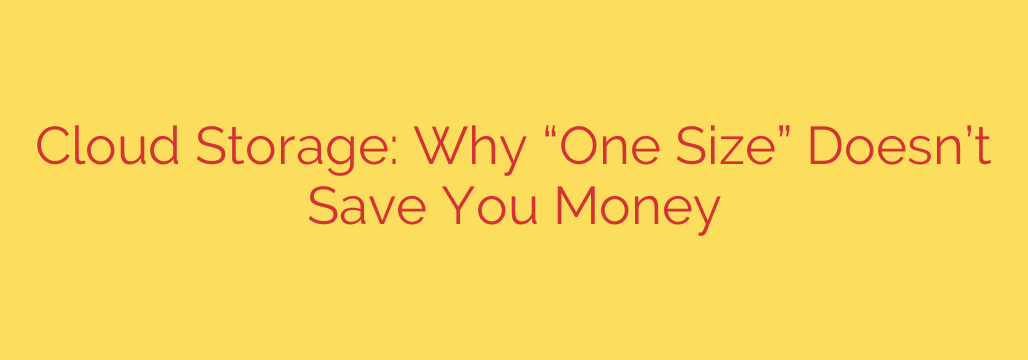
Unlocking Cloud Storage Savings: Why Your One-Size-Fits-All Strategy is Costing You Money
As businesses increasingly migrate to the cloud, a common and costly mistake is treating cloud storage as a single, uniform utility. Many organizations pick a default storage option—often a high-performance, general-purpose tier—and use it for everything from active databases to long-term archives. While simple, this “one-size-fits-all” approach is a silent budget killer, leading to significant overspending.
The key to optimizing your cloud bill is understanding a simple truth: not all data is created equal. To truly control costs, you must match your data to the right storage tier based on its access frequency, performance needs, and retention requirements.
The Myth of a Single Storage Solution
Think of your data like tools in a workshop. You wouldn’t use a delicate screwdriver to break up concrete, nor would you use a sledgehammer for fine electronics. Similarly, using expensive, high-performance storage for data that is rarely accessed is inefficient and wasteful.
The reality is that your data has a lifecycle. Some files are needed instantly and frequently, while others might only be accessed once a year for an audit. Cloud providers recognize this and offer a spectrum of storage classes, each with a different price point and performance profile. Ignoring these options means you’re likely paying a premium for data that doesn’t need it.
A Guide to Smart Storage Tiers
Virtually all major cloud providers (like AWS, Google Cloud, and Azure) structure their storage offerings into tiers. Understanding these is the first step toward significant savings.
Hot Storage: This is the premium, high-performance tier designed for data that is accessed frequently and requires instant availability. Think of active website assets, transactional databases, and real-time data processing. It offers the lowest latency but comes with the highest storage cost. It’s perfect for your most critical, active workloads.
Cool Storage: This tier is a middle ground, designed for less frequently accessed data that still needs to be readily available. Good examples include recent backups, monthly analytics reports, and older project files that are still referenced occasionally. The storage cost is lower than hot storage, but there may be slightly higher fees for accessing the data.
Archive Storage: This is the most cost-effective tier for long-term data retention, compliance, and disaster recovery. This is where you store data you don’t expect to need for months or even years. While the cost per gigabyte is incredibly low, accessing this data comes with two major trade-offs: retrieval times and egress fees.
The Hidden Dangers: Retrieval Times and Egress Fees
The low price of archive storage can be deceptive if you don’t understand the associated costs.
First, retrieval is not instant. Unlike hot storage where data is available in milliseconds, retrieving files from an archive tier can take several hours. This makes it completely unsuitable for any application that requires immediate data access.
Second, and more importantly, are the egress fees—the cost charged by the provider to move your data out of their storage service. While storing data in an archive tier is cheap, retrieving a large volume of it can result in a surprisingly massive bill. Many companies have been caught off guard by the astronomical cost of a large-scale data restore from an archive, sometimes negating years of storage savings.
It is crucial to balance the low storage cost of archive tiers with the potential high cost and slow speed of retrieval.
Actionable Steps to Optimize Your Cloud Storage Costs
Moving to a smarter storage strategy doesn’t have to be complicated. Here are three steps to take control of your spending:
Audit and Classify Your Data: You can’t optimize what you don’t understand. Begin by analyzing your data to determine its access patterns. Identify which data is “hot,” “cool,” and “cold” (archive). This initial audit provides the blueprint for your cost-saving strategy.
Implement Data Lifecycle Policies: All major cloud providers offer tools to automate the movement of data between tiers. You can create rules—known as lifecycle policies—to automatically transition data as it ages. For example, a policy could move a file from hot to cool storage after 30 days of inactivity, and then from cool to archive storage after 180 days. This automation is the single most powerful tool for ongoing cost optimization.
Plan for Retrieval: Before moving data to an archive, create a clear plan for how and when it might be needed. Understand the associated retrieval times and calculate the potential egress fees for a full or partial restore. This ensures you’re prepared for a disaster recovery scenario without facing unexpected financial shock.
By moving away from a single-tier strategy and embracing a more intelligent, tiered approach, you can ensure you’re only paying for the performance you actually need. This proactive management is the difference between letting your cloud bill spiral out of control and transforming cloud storage into a true strategic advantage for your business.
Source: https://datacentrereview.com/2025/08/the-myth-of-one-size-fits-all-cloud-storage-is-costing-you-money/








